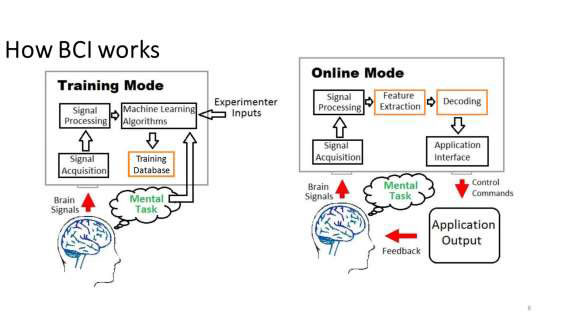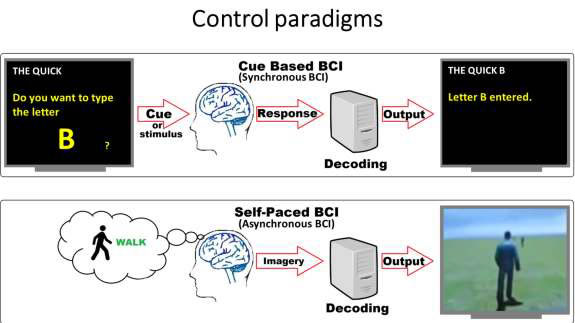Po T Wang's Website
Navigation
Brain Computer Interface
Introduction
My research focuses on Brain Computer Interface, which is a communication pathway between a human brain and a computer device. The goal of a BCI is to decode human brain signals into intentions and commands for controlling computer-controlled devices. Since it reads signals from the brain, it has the ability to bypass nervous system injuries such as spinal cord injury (SCI) and brainstem stroke, and directly control affected limbs via a prosthesis or exoskeleton.
There are more than 7 million people in the US with stroke and SCI. Paraplegia due to SCI alone costs over $340 billion a year. Furthermore, they develop medical co-morbidities such as cardiovascular diseases, diabetes, osteoporosis, and muscular atrophy. BCIs can potentially help them reduce reliance on caregivers and reduce medical costs.
How BCI works

A BCI works by acquiring and decoding the brain signals into control commands. It works on the premise that we can associate certain brain signals with a certain control command. This association is created during the training mode.
Training Paradigms
There are generally two training paradigms. In the user-training paradigm, the brain patterns are pre-determined by the designers of the BCI, and the BCI users are asked to figure out how to change their own brain waves to match those patterns. This can take users a long time (weeks to months) to figure out how to do this, and the strategies they end up using are often unintuitive. It means that the users may have to imagine moving their tongue and feet to control the BCI. On the other hand, the computer-training paradigm uses machine learning algorithms to associate the brain signals to control commands. It can learn how to understand the user much more quickly (10-20 minutes).
Control Paradigms

There are also two online control paradigms. Online means that the user is using the BCI to control an output device in real time. In a cue based (synchronous) BCI, the computer probes the user's brain with stimuli and wait for a special, involuntary response. This could mean flashing icons on a computer screen while the user looks at it. If the user is paying attention to a particular icon, their brain signal changes when the icon is flashed. On the other hand, in a self-paced (asynchronous) BCI, the user generates their own mental imagery, and the computer decodes that into output commands.
Software
GitHub Repositories
Multimedia
Presentations
- Brain Computer Interface in Communication and Control (Presentation, BME Retreat), 3 Oct 2009
- Recent Breakthroughs in Brain-Computer Interface (Presentation, BME Seminar), 22 Oct 2010
- Novel Data Processing Techniques for High-Performance Brain-Computer Interface (Presentation, Ph.D. Defense), 22 Oct 2010
Videos
- Towards Neural Rehabilitation: Brain-Computer Interface Research at University of California, Irvine
- BCI-speller - High-speed BCI Speller
- BCI-controlled avatar (virtual walking simulation) - Able-bodied person - Person with paraplegia - Person with tetraplegia
- BCI-controlled Robotic Gait Orthosis - Able-Bodied Person - Person with Paraplegia SCI
- BCI-controlled overground walking prosthesis - Person with Paraplegia Regains Overground Walking
- BCI-controlled robotic arm - Electrocorticogram (ECoG)-based BCI state decoding of wrist movement
- BCI-assisted neurorehabilitation - Dorsiflexion by stroke subject with foot drop